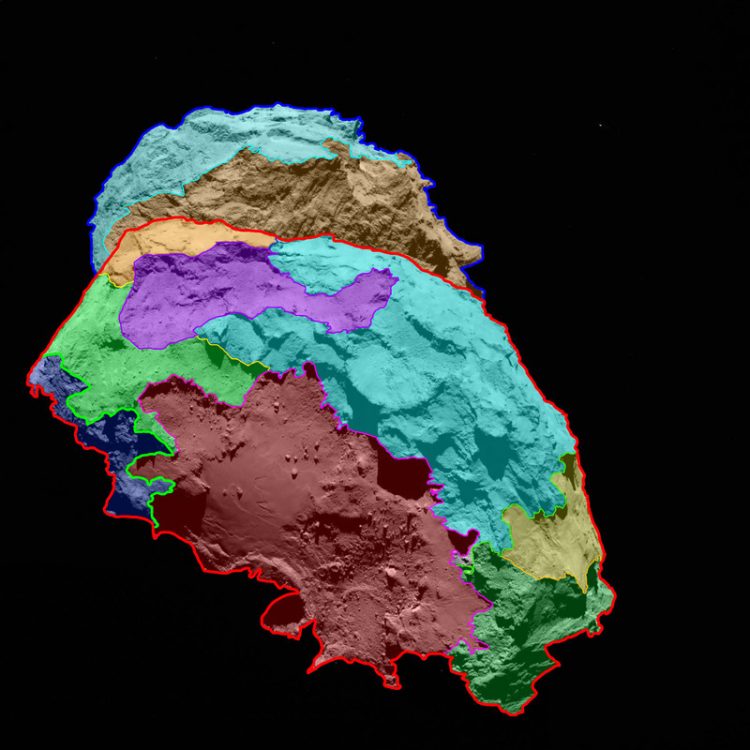A map of Rosetta's comet

In this view of the "belly" and part of the "head" of the comet, several morphologically different regions are indicated. © ESA/Rosetta/MPS for OSIRIS Team MPS/UPD/LAM/IAA/SSO/INTA/UPM/DASP/IDA
High-resolution images of comet 67P/Churyumov-Gerasimenko reveal a unique, multifaceted world. ESA's Rosetta spacecraft arrived at its destination about a month ago and is currently accompanying the comet as it progresses on its route toward the inner solar system.
Scientists have now analyzed images of the comet's surface taken by OSIRIS, Rosetta's scientific imaging system, and allocated several distinct regions, each of which is defined by special morphological characteristics. This analysis provides the basis for a detailed scientific description of 67P's surface.
„Never before have we seen a cometary surface in such detail“, says OSIRIS Principal Investigator Holger Sierks from the Max Planck Institute for Solar System Science in Germany. In some of the images, one pixel corresponds to 75 centimeters scale on the nucleus. „It is a historic moment, we have an unprecedented resolution to map a comet“, he adds.
With areas dominated by cliffs, depressions, craters, boulders or even parallel grooves, 67P displays a multitude of different terrains. While some of these areas appear to be quiet, others seem to be shaped by the comet's activity. As OSIRIS images of the comet's coma indicate, the dust that 67P casts into space is emitted there.
„This first map is, of course, only the beginning of our work“, says Sierks. „At this point, nobody truely understands, how the morphological variations we are currently witnessing came to be.“ As both 67P and Rosetta travel closer to the Sun in the next months, the OSIRIS team will monitor the surface looking for changes.
While the scientists do not expect the borderlines of the comet's regions to vary dramatically, even subtle transformations of the surface may help to explain how cometary activity created such a breathtaking world. The maps will also offer valuable insights for Rosetta's Lander Team and the Rosetta orbiter scientists to determine a primary and backup landing site from the earlier preselection of five candidates.
Rosetta is an ESA mission with contributions from its member states and NASA. Rosetta's Philae lander is provided by a consortium led by DLR, MPS, CNES and ASI. Rosetta will be the first mission in history to rendezvous with a comet, escort it as it orbits the Sun, and deploy a lander to its surface.
The scientific imaging system OSIRIS was built by a consortium led by the Max Planck Institute for Solar System Research (Germany) in collaboration with CISAS, University of Padova (Italy), the Laboratoire d'Astrophysique de Marseille (France), the Instituto de Astrofísica de Andalucia, CSIC (Spain), the Scientific Support Office of the European Space Agency (The Netherlands), the Instituto Nacional de Técnica Aeroespacial (Spain), the Universidad Politéchnica de Madrid (Spain), the Department of Physics and Astronomy of Uppsala University (Sweden), and the Institute of Computer and Network Engineering of the TU Braunschweig (Germany). OSIRIS was financially supported by the national funding agencies of Germany (DLR), France (CNES), Italy (ASI), Spain (MEC), and Sweden (SNSB) and the ESA Technical Directorate.
Contact
Dr. Birgit Krummheuer
Press and Public Relations
Max Planck Institute for Solar System Research, Göttingen
Phone: +49 551 384979-462
Dr. Holger Sierks
Max Planck Institute for Solar System Research, Göttingen
Phone: +49 551 384979-242
Media Contact
More Information:
http://www.mpg.de/8407334/67p_churyumov-gerasimenko_mapAll latest news from the category: Physics and Astronomy
This area deals with the fundamental laws and building blocks of nature and how they interact, the properties and the behavior of matter, and research into space and time and their structures.
innovations-report provides in-depth reports and articles on subjects such as astrophysics, laser technologies, nuclear, quantum, particle and solid-state physics, nanotechnologies, planetary research and findings (Mars, Venus) and developments related to the Hubble Telescope.
Newest articles

Airborne single-photon lidar system achieves high-resolution 3D imaging
Compact, low-power system opens doors for photon-efficient drone and satellite-based environmental monitoring and mapping. Researchers have developed a compact and lightweight single-photon airborne lidar system that can acquire high-resolution 3D…

Simplified diagnosis of rare eye diseases
Uveitis experts provide an overview of an underestimated imaging technique. Uveitis is a rare inflammatory eye disease. Posterior and panuveitis in particular are associated with a poor prognosis and a…

Targeted use of enfortumab vedotin for the treatment of advanced urothelial carcinoma
New study identifies NECTIN4 amplification as a promising biomarker – Under the leadership of PD Dr. Niklas Klümper, Assistant Physician at the Department of Urology at the University Hospital Bonn…





















